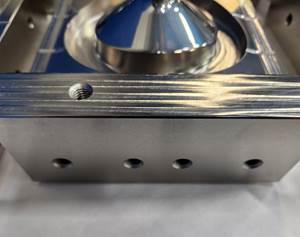Solvent Substitution Strategies for Finishers
Evaluation of alternative solvents using the Hansen solubility parameters.
Along with a desire to reduce flammability, enhance worker health and safety, and reduce costs, the solvent selection process has become increasingly complex. In-house evaluation of alternative solvents can be aided by understanding: 1) the Hansen solubility parameters of surfaces, soils and solvents; 2) solvent selection to fit within an EHS profile; and 3) solvent blending to maximize performance.
by Darren L. Williams, Ph.D.
The cleaning, machining, adhesives, coatings, and inks industrial sectors have all been affected by restrictions on ozone-depleting (OD) solvents, hazardous air pollutants (HAPs), smog-producing volatile organic carbons (VOCs), and solvents with a high global warming potential (GWP).
Along with a desire to reduce flammability, enhance worker health and safety, and reduce costs, the solvent selection process has become increasingly complex. In-house evaluation of alternative solvents can be aided by understanding: 1) the Hansen solubility parameters of surfaces, soils and solvents; 2) solvent selection to fit within an EHS profile; and 3) solvent blending to maximize performance.
The theory of “solvent-soil interactions” is that the cleaning solvent, surface and soil must spontaneously “like each other.” A negative Gibbs energy of mixing (∆Gmix) indicates that the substances “like” each other enough to mix spontaneously.
The DGmix can be written (See Eq. 1) in terms of the enthalpy of mixing (DHmix), the entropy of mixing (DSmix), and the temperature of the system (T).
The entropy of mixing depends on the volume fractions (xi = vi/VT) of each of the components (See Eq. 2) as well as the total number of moles of molecules (nT) and the gas constant (R) 8.3145 J mol-1 K-1. In Eq. 2, all the volume fractions are less than one, which means it is always entropically favorable to form mixtures.
If substances don’t spontaneously mix, it’s due to the enthalpy of mixing. Hildebrand and Scott coined the term “solubility parameter” (dT in Eq. 3), defined as the square root of the enthalpy of vaporization (DHvap) for a solvent divided by its molar volume (Vm). It is expressed in either (J/mL)1/2 or the numerically equivalent MPa1/2.
Each substance has a Hildebrand solubility parameter and these can be compared to yield the enthalpy of mixing via Eq. 4. So you can predict that mixing will occur if two substances have similar Hildebrand solubility parameters. Hansen refined this approach to account for three types of intermolecular forces: dispersion (dD), polarity (dP), and hydrogen-bonding (dH), thus creating the Hansen solubility parameters (HSPs). They are related to dT via the geometric mean (See Eq. 5).
This is a useful system for understanding intermolecular attractions because the HSPs of solvents and soils can be plotted in a three-dimensional Hansen solubility coordinate space (See Fig. 1).
The HSPs of these solvents were obtained from HSPiP software, although determining the HSPs of the soil may be as easy as an Internet search if the soil is a commercial oil or grease. Once the soil HSPs are known, solvent substitution and blend prediction can begin.
Solvent-Surface Interactions
Spontaneous wetting of a surface by a solvent is indicated by a negative change in free energy per unit area (DGwetting). Where Gsurface is the initial surface energy of the surface, and Gsolvent is the surface energy (liquid-vapor surface tension, gl,v) of the solvent. If the solvent has a lower surface energy than the substrate, it will spontaneously wet the surface. Surface tension is easily found in tables for pure solvents. For blends, a simple measurement can be made using a surface tensiometer. If measurement is impractical, Eq. 7 can be used to estimate the solvent surface tension.
Solvent Blend Evaluation, Prediction and Selection
The HSPs of a blend are simply the volume-fraction-weighted sums of the HSPs of the blend components (Eq. 8). In Eq. 8, the dD,i represents the dispersion Hansen solubility parameter for the i-th component of the blend. The same treatment is used for the dP,blend and dH,blend parameters. One may also approximate the molar volume of the blend by a weighted average of the molar volumes of the components.
Essentially, binary blends are represented in DPH-space by a straight line between the two components; a three-component blend forms a triangle; and a four-component blend forms a four-sided polygon. If the soil HSPs lie close to the triangle or within the polygon, these blend components will produce a promising blend. Software is available that will search for the optimum blend recipe targeting the HSPs of a given soil.
Desirability Rankings
To determine an overall desirability function for ranking the many possible blend recipes, there are five common criteria – Flammability (F), Toxicity (H), Volatility (Y), Surface Tension (W), and Effectiveness (E). For the purposes of optimization, each criterion is transformed into a 0 (bad) to 1 (good) scale.
The flammability rating uses the Hazardous Material Identification System (HMIS) on the MSDS that ranks flammability from 0 (low) to 4 (high), and Eq. 9 converts this to the necessary 0 to 1 range. A similar treatment is used for the toxicity rating from the HMIS term as seen in Eq. 10.
Volatility is based on the solvent evaporation rate (RER) relative to n-butylacetate. Because the magnitude of RER may vary from near-zero to several thousand, the inverted percentile rank of the RER relative to the full set of solvents under consideration is used. In English, the most volatile solvent will have a near-zero rank and the least volatile solvent will have a rank near one. (The non-inverted percentile rank may be used if fast-evaporating solvents are desired. This percentile rank is based upon a normal distribution function, which is standard in Excel (See Eq. 11).)
A similar treatment is used to rank the surface tension of candidate solvents from high (0) to low (1) so that good wetting properties (Wi) can be favored in the evaluation as well.
The predicted effectiveness of a solvent against a particular soil is captured in the Hansen distance term (Ra, Eq. 13). The inverted percentile rank (See Eq. 14) is used on Ra to transform small Ra to values near 1 and large Ra to values near 0. Individual rankings are averaged (See Eq. 15) to give a desirability rating for each solvent.
For blended solvents, desirability ratings (Di) of the blend components are averaged along with the blend effectiveness rating (Eblend) to determine overall blend desirability (See Eq. 16). The N in Eq. 16 represents the number of blend components. Blend effectiveness (Eblend) is calculated using the Hansen distance of the blend to the soil using Eq. 14.
To illustrate this process, a silicone-based high vacuum grease (HVG) was chosen as the soil. The Hansen solubility parameters were determined to be 16.0, 2.3, 1.4 using the solvent interaction method. The Hansen distances from 14 common solvents to HVG are shown in Table 1 as well as the desirability ratings of each solvent against HVG.
One can see in Table 1 that both HFE71 and Sols are comparable replacements for AK225 for this particular soil. The HFE73 solvent is potentially lacking in effectiveness for this soil. The effectiveness of d-limonene is good, but dLIM suffers in all other categories. This is a good example of balancing risk and requirements in solvent substitution decisions. All 91 pairwise combinations of these solvents were computed and Table 2, shows optimized blend recipes for the top 16 binary blends, sorted by desirability.
This process should guide you toward the most promising solvent replacement candidates, all prepared for cleaning effectiveness and miscibility testing.
Acknowledgement: this work has been developed over the years with funding from SHSU, US-DOE, NASA-WSTF, and the Welch Foundation. Charles Hansen, Steven Abbott, Hiroshi Yamamoto, Karl Kuklenz, and James Huskey are acknowledged.
Darren L. Williams, Ph.D., is an associate professor in the chemistry department at Sam Houston State University in Huntsville, Texas. He can be reached at williams@shsu.edu.
Related Content
Finishing High Reliability, Function Critical Parts
From safety critical automotive and aerospace components to lifesaving medical micro-components and implantable devices, Indiana-based Electro-Spec finishes applications that require zero failure rates.
Read MoreEngineered Coatings Offer Improvement for Medical Device Manufacturers
Diamond electroless nickel coating provides better lubricity and improved wear resistance for molds, resulting in better quality and productivity.
Read MoreCustom Plating Technology Enables Medical Devices
Finisher collaboration during product design delivers plating solutions for medical OEMs.
Read MoreMasking Solutions for Medical Applications
According to Custom Fabricating and Supplies, a cleanroom is ideal for converting, die cutting, laminating, slitting, packaging and assembly of medical-grade products.
Read MoreRead Next
Delivering Increased Benefits to Greenhouse Films
Baystar's Borstar technology is helping customers deliver better, more reliable production methods to greenhouse agriculture.
Read MoreEpisode 45: An Interview with Chandler Mancuso, MacDermid Envio Solutions
Chandler Mancuso, technical director with MacDermid Envio discusses updating your wastewater treatment system and implementing materials recycling solutions to increase efficiencies, control costs and reduce environmental impact.
Read MoreEducation Bringing Cleaning to Machining
Debuting new speakers and cleaning technology content during this half-day workshop co-located with IMTS 2024.
Read More











.jpg;maxWidth=300;quality=90)
















